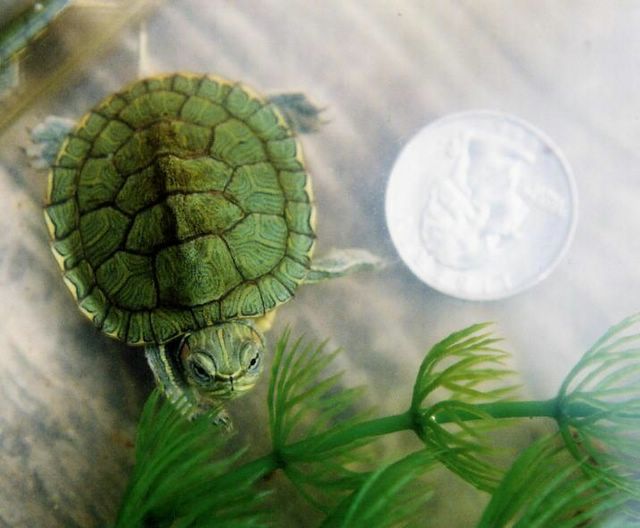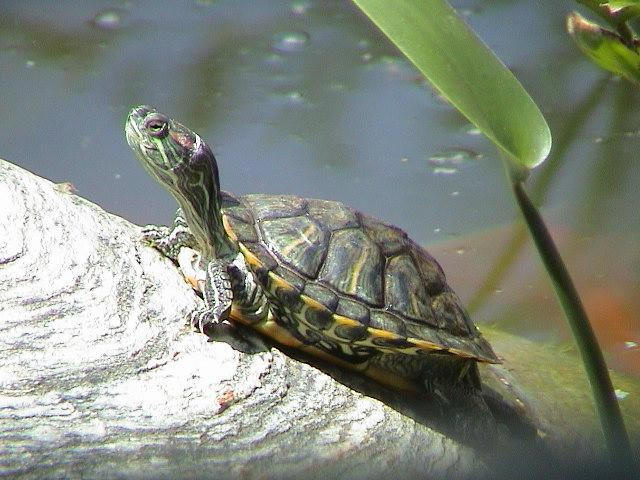| Data Sheet | | |
| Scientific Name: | Trachemys scripta elegans | |
| Family: | Emydidae | |
| Origin: | USA, Mexico, Guatemala, Belize, Honduras, El Salvador, Nicaragua, Costa Rica, Panama, Brazil, Venezuela | |
| Adult Size: | 28 cm (8-9" inches) | |
| Social: | They will tolerate other small animals in their habitat, but will quickly dive underwater when approached by potential predators, making them difficult to catch. | |
| Lifespan: | 25 years - 40 years | |
| Tank Setup: | Requires freshwater and land. | |
| Minimum Tank Size: | A 12 x 6 x 6 inches (30 x 15 x 15 cm) tank would be suitable for a single small terrapins up to 10 cm (4 inches) shell length. | |
| Diet: | Omnivore | |
| Breeding: | Egg Layer | |
| Care: | Easy-Medium | |
| Ideal pH: | 6.5-7.5 | |
| Temperature: | 20 - 26 C (69 - 78 F) | |
| Tank setup:
| Place the terrapin in a tank with shallow water, some logs or rock so that it can sun itself. | |
| Sexing: | Males have longer front claws and a longer, thicker tail. Males also tend to have a concave ventral shell as compared to that of females. When full grown, females are also significantly larger than males. | |
|
| Description:This is a sleek turtle, with webbed feet and a red stripe down each side of the head. The carapace (upper shell) is patterned with yellow and green markings. The shells of juveniles are bright green, and this darkens with age. The face shows a distinctive arrangement of pale yellow stripes, and red markings behind the ear. Habitat/Care:The red-eared terrapin inhabits still or slow flowing water with thick underwater vegetation. Primarily active during the day, it likes to haul out onto land, roots or floating logs to soak up the sun's heat. Red-eared terrapin are amphibious, spending time in water as well as on land. Water depth needs to be approximately the width of the shell for juveniles but should be no deeper than 5 cms for hatchlings. Therefore, the tank should ideally contains some logs or rock so that it can sun itself. Diet:Red-eared sliders are omnivores, feeding on vegetation, insects, small fish, frogs and tadpoles. They eat more tadpoles fish and insects when young, switching to more plants as they age. "Turtle foods" comprising of dried river shrimps as sold in pet shops can be added as a source of roughage. Breeding:The male has very long front claws and the courtship behaviour involves him swimming in front of the female and tickling her chin. The female usually lays eggs once a year, sometimes twice. The clutch averages about 15 eggs but can be anything from 2-22 eggs. The female terrapin excavates a pit where she lays the eggs at intervals of three to ten minutes. She then covers the pit and leaves them to develop. Hatching occurs after about three months, or less if conditions are warmer. For more information on breeding this terrapin, I recommend reading reference #5 below. |
Warning:Red-Eared Terrapins have a strong bite resulting in injuries that should be seen by medical staff as soon as possible as they may carry some diseases. This bite is able to inflict serious injury, larger adults being able to crush bone. Disease1. Soft shell/ lumpy shell: lack of calcium or lack of Vitamin D 3 which promotes healthy bone and shell growth. 2. Swollen/ closed eyes: this can lead to loss of vision and an inability to feed. It can be caused by infection, lack of vitamin A, incorrect feedingor incorrect environmental conditions. 3. Shields: terrapin shields or scutes covering the shell do not grow, so every few months you may find they "moult". The new shield underneath will be brightly coloured. Check that the terrapin is feeding and behaving normally. However, if there is any sign of blood, or the terrapin appears listless or off its food, seek advice from your veterinary surgeon immediately. | |
Photo Galley
Got a photo? Contact me.
 |  |  |
 |  |  |
 |  Photo courtesy of Linda |  Photo courtesy of Linda |
Links to other awesome Red-Ear Terrapin sites:
1. http://www.crislis2.f9.co.uk/herpcapbreed/redear.htm awesome pics for reptiles, including terrapins.
2. http://www.ecologyasia.com/verts/turtles/red-eared_terrapin.htm - turtles of Southeast Asia showcase information about various turtles.
3. http://www.natureportfolio.com/reptiles/turtles_terrapins.php - includes images on various turtles.
4 http://www.seacave.com/testsite/livestock/turtles.php - a place where you can buy turtles as pets.
References Cited:
1. Red-Eared Terrapin [Online], Available, http://www.bristolzoo.org.uk/learning/animals/reptiles/red-eared-terrapin
2. Red-eared Slider [Online], Available http://en.wikipedia.org/wiki/Red-eared_Terrapin
3. Red-eared Terrapin [Online], Available http://www.ecologyasia.com/verts/turtles/red-eared_terrapin.htm
4. Red-eared Terrapin - Trachemys scripta elegans [Online], Available http://www.deancloseprep.gloucs.sch.uk/chelonia/care%20sheets/redear.htm
5. Breeding the Red Eared Terrapin, [Online], Available, http://www.deancloseprep.gloucs.sch.uk/chelonia/paulsarticles/pvcret.htm




























No comments:
Post a Comment